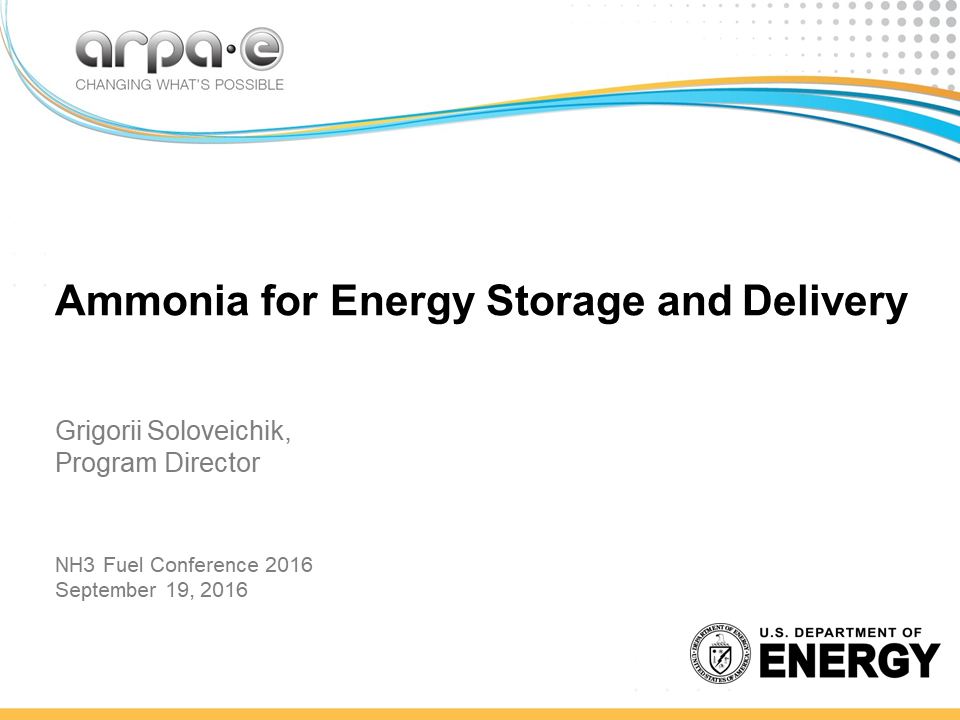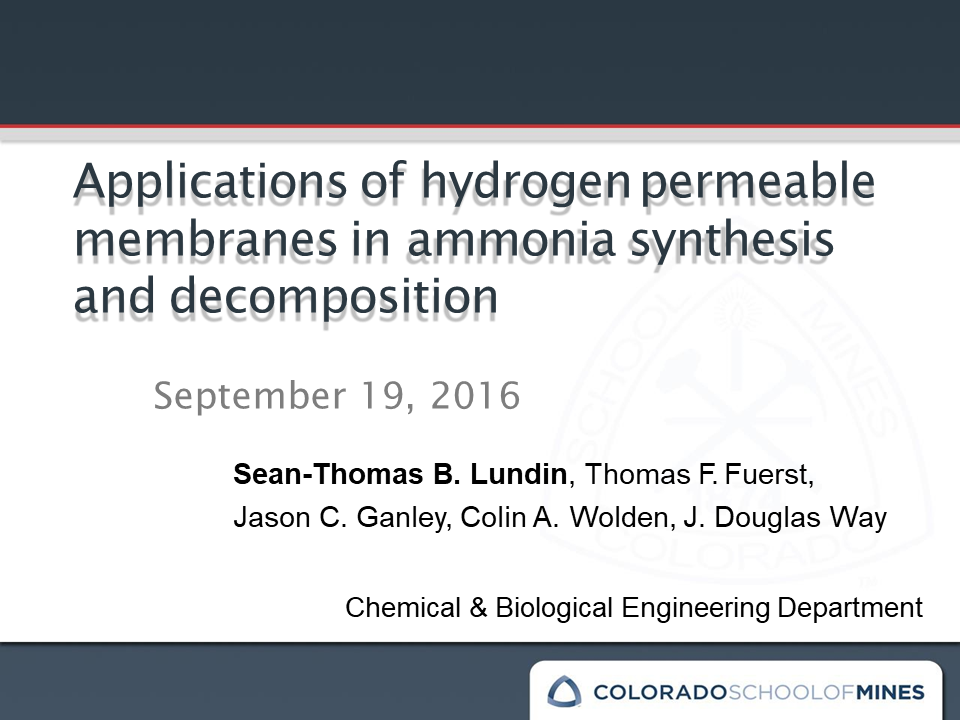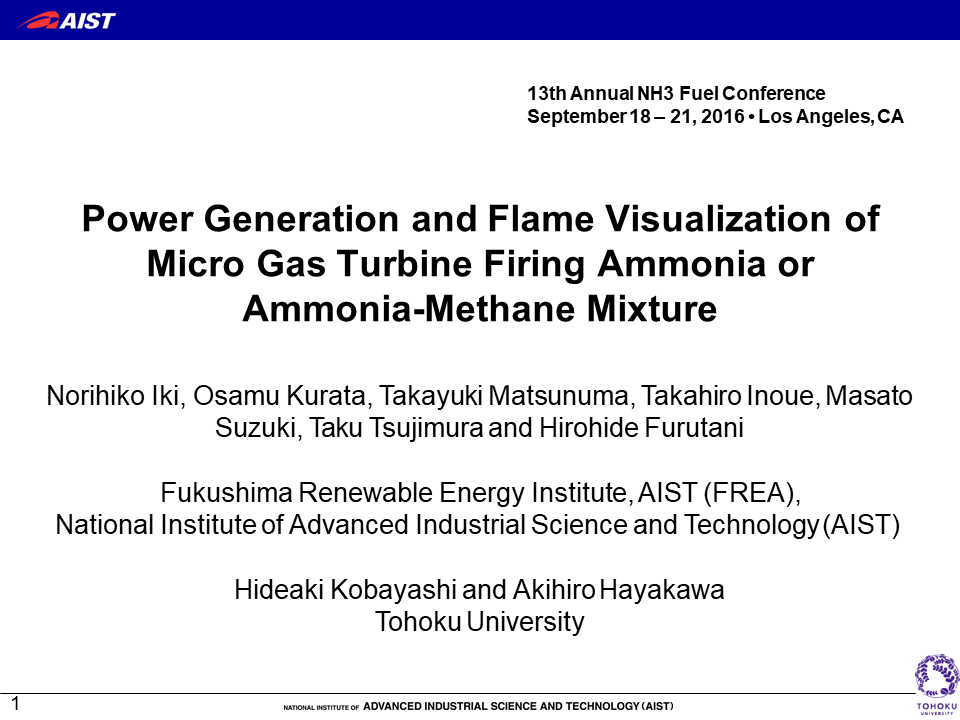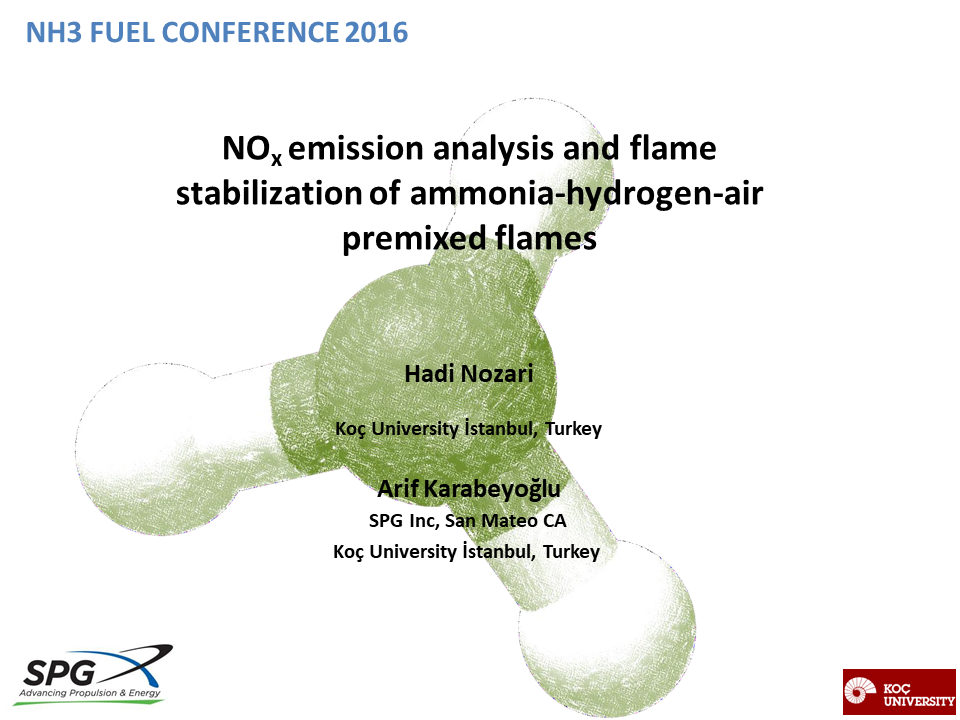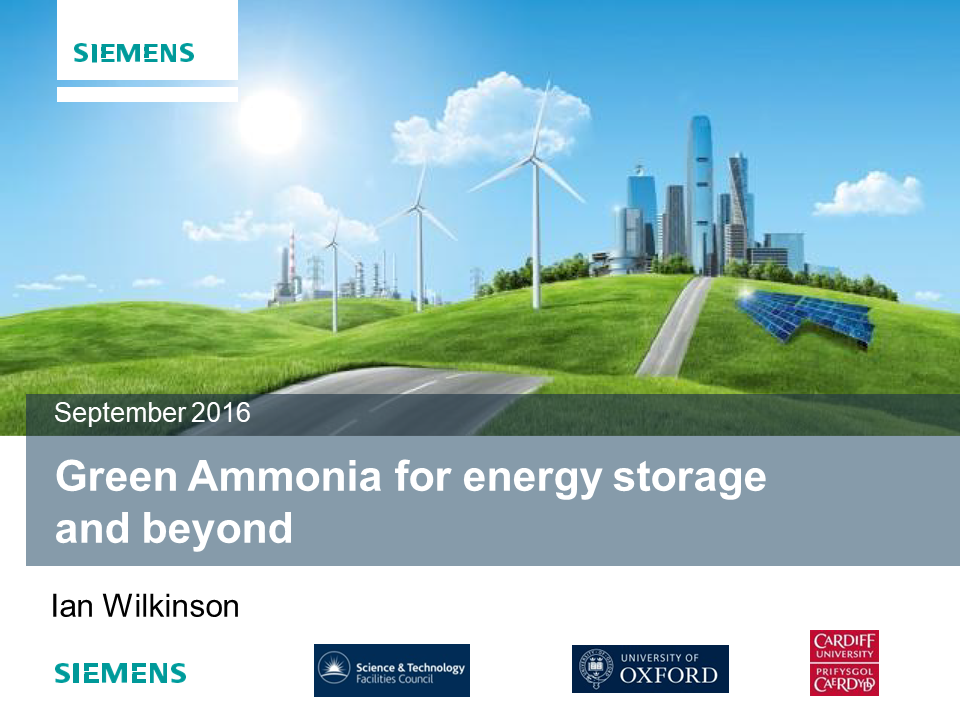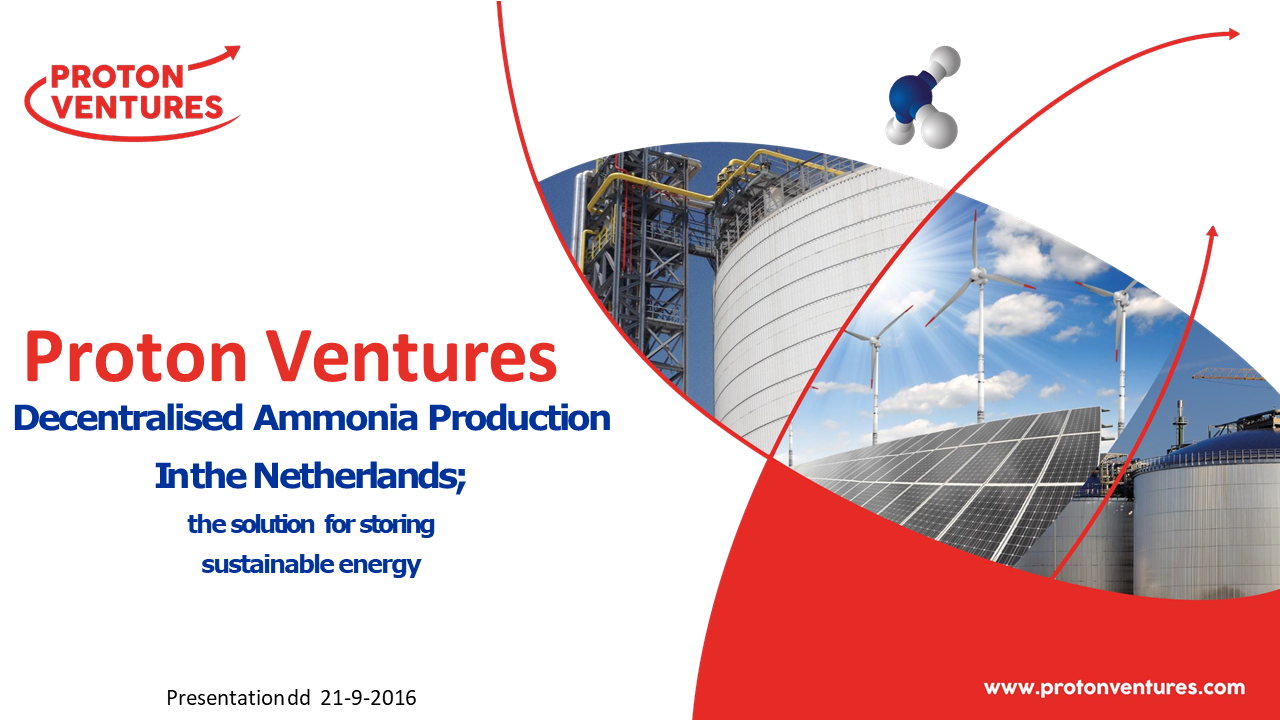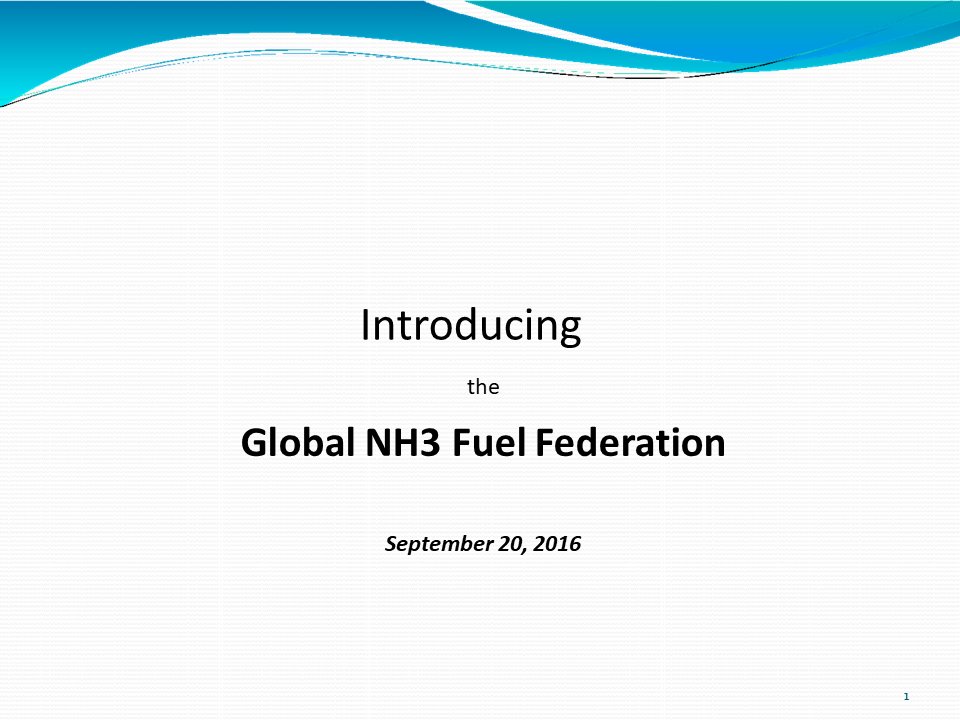NH3 Fuel Conference 2016
September 18, 2016 September 21, 2016 UCLA Luskin Conference Center Los Angeles United States
18 – 21 September
Schedule
Keynote Address
Monday, September 19, 2016
Presentation
Ammonia for Energy Storage and Delivery
The Advanced Research Projects Agency (ARPA-E) funds high risk, high reward transformational research to reduce energy related emissions, reduce imports of energy from foreign sources, improve energy efficiency across all economic sectors, and ensure US technological lead in advanced energy technologies, including electrochemical energy storage and transformation for grid scale and automotive applications. Storing energy in the form of liquid fuels has numerous advantages compared to conventional methods of energy storage (ES) such as batteries (high cost, short cycle life), pumped hydro and compressed air (low energy density). Low costs of storage and transportation of liquid fuels enables long-time ES…
Presentation
NH3: The Optimal Alternative Fuel
NH3: The Optimal Alternative Fuel Norm Olson, NH3 Fuel Association
NH3 Synthesis Session: Facilitated by Adrienne Lavine, UCLA
Monday, September 19, 2016
Presentation
Thermochemical energy storage with ammonia and implications for ammonia as a fuel
This seminar presents recent advances in ammonia-based thermochemical energy storage1 (TCES), supported by an award from the US Department of Energy SunShot program. The goal of SunShot is to “reduce the total installed cost of solar energy systems to $.06 per kWh by 2020.” Within the arena of concentrating solar thermal power, Sunshot has established goals for each subsytem, including reducing the cost of the energy storage subsystem to $15 per kWht of stored energy and enabling working fluid temperatures greater than 600°C, consistent with advanced, high performance power blocks. Schematic of an NH3-based thermochemical energy storage system. In ammonia-based…
Presentation
Ammonia Fuel Cell and Fuel Synthesis Using Protonic Ceramics
Proton-conducting ceramics synthesized with solid-state reactive sintering are employed as electrolytes for the synthesis of ammonia from hydrogen and nitrogen gases in electrolytic cells. Additionally, these cells function with excellent long-term stability and high efficiency when operated in galvanic (fuel cell) mode using ammonia fuel. Advances in electrolyte compositions and synthesis techniques are discussed alongside cell performance metrics.
Presentation
Small Scale Low-Pressure Ammonia Synthesis
Ammonia is one of the most important chemical commodities in the US and will be a key component in helping the world meet the rising demand for food and energy. Ammonia is needed in distributed locations for agriculture (as fertilizer for small grain and corn production), for indirect hydrogen storage1 (transported as a liquid at moderate pressure to hydrogen stations), or as a liquid fuel2 (for internal combustion engines or solid oxide fuel cells). Recently, there has been significant effort to develop scalable technologies for conversion of intermittent energies (e.g., solar, wind) into energy dense carbon-neutral liquid fuels, and ammonia…
Presentation
Progress in the Electrochemical Synthesis of Ammonia
Ammonia is one of the most important and widely produced chemicals worldwide with a key role in the growth of human population. Nowadays, the main route for ammonia synthesis is the Haber-Bosch process, developed one century ago. In this process, Fe-based catalysts are usually employed at temperatures between 400 and 500°C and pressures between 130 and 170 bar. As opposed to the industrial process, in nature, plants and bacteria have been producing ammonia for millions of years at mild conditions. Atmospheric nitrogen is reduced by solvated protons on the FeMo cofactor of the metalloenzyme nitrogenase. The natural method of nitrogen…
Presentation
Ammonia Safety Public Awareness
Ammonia Safety Public Awareness John Scherer*, Jeremy Olberding, Global Cold Chain Alliance
Presentation
Applications of hydrogen permeable membranes in ammonia synthesis and decomposition
It is well known that ammonia is being considered as a method of storing hydrogen. Although some fuel cells are being developed that can use ammonia directly as a fuel source, many fuel cell technologies still require an outside cracker to revert ammonia back into hydrogen for efficient use. In this regard, hydrogen permeable membranes, such as Pd and its alloys, have been targeted as potential membrane reactors in which the ammonia is cracked while the hydrogen is simultaneously separated. Pd and its alloys are expensive, but offer potentially perfect hydrogen purity that is highly preferable for certain fuel cells…
NH3 Fuel Use Session: Facilitated by Bill David, University of Oxford
Monday, September 19, 2016
Presentation
Cracking ammonia
In this talk, I will discuss our latest research in developing novel ammonia cracking catalysts. While ammonia can be used directly as a fuel in high temperature fuel cells, internal combustion engines and gas turbine, the ability to crack ammonia affordably and effectively increases the range of possibilities for utilising ammonia as an energy vector. For example, the production of an ammonia-free hydrogen/nitrogen gas mixture permits the consideration of ammonia as an on-board hydrogen storage option for transportation. Furthermore, the ability to partly crack ammonia provides an increased flexibility for internal combustion engines. I will outline developments in our search…
Presentation
Research and Development of Ammonia-fueled SOFC Systems
Koichi EguchiAtthapon SrifaTakeou OkanishiHiroki MuroyamaToshiaki MatsuiMasashi KishimotoMotohiro SaitoHiroshi IwaiHideo YoshidaMasaki SaitoTakeshi KoideHiroyuki IwaiShinsuke SuzukiYosuke TakahashiToshitaka HoriuchiHayahide YamasakiShohei MatsumotoShuji YumotoHidehito KuboJun KawaharaAkihiro OkabeYuki KikkawaTakenori Isomura
Ammonia is a promising hydrogen carrier because of its high hydrogen density, low production cost, and ease in liquefaction and transport. Ammonia decomposes into nitrogen and hydrogen through a mildly endothermic process. The ammonia decomposition temperature is close to the operating conditions of solid oxide fuel cells (SOFCs). Therefore, the integration of these two devices is beneficial in terms of efficient heat and energy managements and will lead to the development of simplified generation systems. We have investigated three types of ammonia-fueled SOFC systems. In one system, ammonia is directly supplied to the anode chamber. Ammonia decomposes into nitrogen and…
Presentation
Power Generation and Flame Visualization of Micro Gas Turbine Firing Ammonia or Ammonia-Methane Mixture
Norihiko IkiOsamu KurataTakayuki MatsunumaTakahiro InoueTaku TsujimuraHirohide FurutaniHideaki KobayashiAkihiro Hayakawa
A demonstration test with the aim to show the potential of ammonia-fired power plant is planned using a micro gas turbine. 50kW class turbine system firing kerosene is selected as a base model. A standard combustor is replaced to a prototype combustor which enables a bi-fuel supply of kerosene and ammonia gas. Diffusion combustion is employed to the prototype combustor due to its flame stability. 44kW power generation was achieved by 100% heat from ammonia gas. Although NOx concentration in the exhaust gas of ammonia combustion exceeded 500ppm, NOx removal equipment reduced NOx concentration below 10ppm. Over 30kW power generation…
Presentation
NOx emission analysis and flame stabilization of ammonia-hydrogen-air premixed flames
Based on its well-known merits, ammonia has been gaining special attention as a potential renewable energy carrier which can be replaced in power generation units. One of the major challenges with ammonia as a fuel is NOx emission, which has a complex underlying chemical kinetics. In an earlier chemical kinetics study by the authors, NOx formation sensitivity was thoroughly studied in a wide range of combustion conditions [Nozari & Karabeyoğlu, J.Fuel 2015]. As the next step, premixed ammonia-hydrogen-air flames are studied experimentally in standard temperature and pressure condition. Effects of some major influential parameters on NOx emission levels are investigated:…
Presentation
Combustion characteristics of ammonia/air flames for a model swirl burner and an actual gas turbine combustor
Akihiro HayakawaK.D. Kunkuma A. SomarathneEkenechukwu Chijioke OkaforTaku KudoOsamu KurataNorihiko IkiHideaki Kobayashi
Ammonia is expected not only as hydrogen energy carrier but also as carbon free fuel. For an industrial use of ammonia combustor, ammonia flame stabilized on a swirl combustor should be clarified. However, in order to realize an ammonia-fueled combustor, there are some issues to be solved, such as a difficulty of flame stabilization and reductions of NOx and ammonia emission. In this study, stabilization and emission characteristics of ammonia / air flames stabilized by a model swirl burner are investigated. The outer and inner diameters of the swirler are 24 mm and 14 mm, respectively, and the swirl number…
Presentation
Development of ammonia / natural gas dual fuel gas turbine combustor
NH3 is a carbon-free fuel, so it has the potential to reduce CO2 emission from the power plant when used as a fuel. However, NH3 has combustion characteristics different from conventional hydrocarbon fuels. The N atom in the ammonia molecule causes high NOx emission through combustion reactions. To develop a gas-turbine combustor, which burns a combination of NH3 and natural gas with controlled emissions, combustion characteristics have been studied experimentally and numerically by using a swirl-burner, which is typically used in gas-turbines. Detailed exhaust gas compositions of the burner have been measured under atmospheric pressure and fuel lean conditions. As…
Presentation
Ammonia Storage in Metal Ammines
Ammonia has attracted interest as a promising alternative fuel for internal combustion engines due to the fact that ammonia does not release carbon dioxide during combustion.[1] Storing ammonia in the form of metal ammines is the most notable way to overcome the challenges that are related to the use of NH3 in liquid form, namely the toxicity and corrosive nature of ammonia.[2] Ammine complexes of light transition metal halides (such as Co, Ni) are very promising candidates because they exhibit high ammonia contents and they are relatively stable at room temperature. The CoX2 system is an interesting candidate, especially cobalt…
Presentation
Solar Hydrogen and Ammonia System Status
Further development results of the Raphael Schmuecker Memorial Solar Hydrogen and Ammonia prototype plant, discussing making of Nitrogen and Ammonia, the energy usage, and the general system efficiencies and output. We would also like to discuss our results of dyno testing the Hydrogen / Hydrogen & Ammonia tractor engine and further developments in ammonia fuel vaporization.
Presentation
Carbon Free liquid fuel for tomorrow's piston and turbine generators
In the 1960s the US Army and University of California modified and flew military helicopter and fixed-wing turbine aircraft by burning pure ammonia. The plan was to generate NH3 from local air & water in remote locations, sparing little expense by modifying only the engine’s firebox and air intake. We’re all here to reduce the cost of air travel, placate noise complainers, and grab our share of the massive growth of future airline cash-flow. Nonsense. The real goal is not fuel efficiency but Carbon-free air travel; electric-hybrids with current engine-generators. Americans bought 6,000,000,000 pounds of liquid NH3 last year.
Day Two Keynote Address
Tuesday, September 20, 2016
Presentation
Overview of the KIER’s Electrochemical Ammonia Synthesis – Present State and Perspective
Ammonia has a potential as a carbon-free energy carrier since it contains 17.6wt% of hydrogen and can be easily stored and transported safely and efficiently. The state-of-the-art industrial process for ammonia production is the Haber-Bosch process. Although high temperature (450–500 °C) and pressure (150–300 bar) are used to dissociate triple-bonded nitrogen and to maximize the ammonia formation, the efficiency of the Haber–Bosch process is limited to 10–15%. Moreover, the process accompanies high greenhouse gases emission since hydrogen is produced from natural gas. In order to overcome the drawbacks of the Haber-Bosch process, the electrochemical ammonia synthesis has been developed as…
NH3 Storage and Safety Session: Facilitated by John Mott, Gordon Bros
Tuesday, September 20, 2016
Presentation
The Benefits of Ammonia Fuel for Transport, Storage, and Safety
The Benefits of Ammonia Fuel for Transport, Storage, and Safety John Mott, Gordon Bros Limited, Australia
Presentation
Ammonia Storage Materials Using Metal Halides and Borohydrides
Ammonia (NH3) is easily liquefied by compression at 1 MPa and 25 °C, and has a highest volumetric hydrogen density of 10.7 kg H2 /100L in hydrogen carriers. The volumetric hydrogen density is above 1.5 times of liquid hydrogen at 0.1 MPa and -253 °C. The vapor pressure of liquid NH3 is similar to propane. Moreover it has a high gravimetric hydrogen density of 17.8 mass%. NH3 is burnable substance and has a side as an energy carrier which is different from other hydrogen carriers. The heat of formation of NH3 is 30.6 kJ/molH2. The value is about 1/10 of…
Presentation
Japan – a future market for Australian solar ammonia
Japan and Australia are intimately linked in energy trade. Australia counts energy exports as a major source of foreign exchange income and Japan, which uses nearly 4 times the primary energy as Australia, imports nearly all of it. Approximately 40% of Australia’s coal exports are bought by Japan and were worth $AUD15.4 billion in 2012-13. Over 70% of Australia’s LNG exports went to Japan in the same period and earned over $AUD12billion. Future energy supply is high on the agenda for Japan. Currently 43% of its primary energy is in the form of imported oil mostly from the Middle East.…
Presentation
Electro-Synthesis of Ammonia for Grid Scale Energy Storage
Shekar BalagopalMatt RobbinsAlvare JavierMarc FlindersJoshua JohnstonFernando GarzonJamie GomezCourtney KrellerRangachary MukundanYu Seung Kim
Ceramatec Inc., in partnership with its partners, will develop a lower temperature and higher efficiency membrane process to synthesize ammonia for energy storage. Ammonia (NH3) is carbon-free, has a high energy density (>4 kW/l), which enables many hours of energy storage from large renewable power projects in small areas, and can be back converted to electricity using turbines or fuel cells at high efficiency. Ammonia synthesis is currently carried out in very large Haber-Bosch plants, mostly fueled from natural gas. The current large-scale Haber-Bosch (H-B) technology needs to run at constant inputs of energy and reactants. Moreover, ammonia is an…
Presentation
Developments in Electrochemical Ammonia Synthesis
Proton Energy Systems, d/b/a Proton OnSite, is a technology and commercialization leader in the field of membrane based electrolysis. The company was founded on the vision of utilizing electrolysis technology for the capture and storage of energy in high value applications. Recently, the concept of storing electrical energy in the form of a carbon neutral liquid fuel, particularly ammonia, has been gaining traction within the research investment community. Proton has been participating in collaborative research with the University of Minnesota to advance the system concept for distributed ammonia production using wind-derived hydrogen (via electrolysis) and subsequent conversion to ammonia using…
Presentation
Ammonia for Green Energy Storage and Beyond
Siemens is participating in an all electric ammonia synthesis and energy storage system demonstration programme at Rutherford Appleton Laboratory, near Oxford. The demonstrator, which will run until December 2017, is supported by Innovate UK. Collaborators include the University of Oxford, Cardiff University and the Science & Technology Facilities Council.
NH3 Fuel Policy Session: Facilitated by Peter Sinsheimer, UCLA
Tuesday, September 20, 2016
Presentation
Piloting a Combined Heat and Power / Distributed Generation System, Powered by Carbon-Free, Renewable-Based Anhydrous Ammonia
UCLA-STPP is an interdisciplinary science / policy research unit, enjoining faculty in schools of engineering, public health, law, business, and medicine. The two-part mission of UCLA-STPP is to: (1) evaluate the viability of safer, cleaner, greener, more sustainable substitutes for existing hazardous services, processes, systems, and/or technologies, and (2) employ diffusion analysis to identify institutional, policy, and regulatory barriers to the adoption of viable safer substitutes and prescribe policy changes to overcome key barriers. UCLA-STPP has taken leadership in developing and institutionalizing “alternatives analysis” as policy/regulatory tool as a method to evaluate and identify safer, cleaner, greener, more sustainable substitutes.…
Presentation
Decentralised ammonia production in the Netherlands
Our presentation will summarize the results of two government funded research projects Proton carried out over the last year. The presentation will give an overview of the Dutch power and chemicals (ammonia) markets. We will start by including a brief history of both markets, current trends and foreseen problems. We propose that electrification of the chemical industry will solve the anticipated problems.
Presentation
Ammonia as a Key to Meeting the Fuel Demand of China
Currently, China is facing a challenge of increasing its energy consumption and simultaneously decreasing its emissions. Particularly, the desire of owning a car is so strong in China that it cannot be easily mitigated by high pricing or taxing. This paper presents the statistical results of fuel consumption in China and predicts the fuel demand in near future, it then compares the fuel demand of China with the fuel production scale of the world. It is concluded that China must utilize clean alternative fuels to meet the fast increasing demand for automotive fuels. The price, distribution infrastructure, and thermodynamic properties…
Presentation
The Investment Case for Sustainable Ammonia Synthesis Technologies
For 100 years, we have made ammonia with the Haber-Bosch process, almost always using a fossil fuel feedstock. Recently, though, government policy, academic innovation, commercial opportunity, and human morality have combined to spur the development of new, “green” ammonia manufacturing processes: sustainable, low-carbon technologies. These new synthesis methods augur a future in which, instead of the single, over-riding drive toward the economies of scale associated with Haber-Bosch, an array of different feedstocks, uses, and business models will support a multiplicity of competing technologies serving multiple markets. This presentation aims to introduce the factors affecting the appetite for commercialization and adoption…
Presentation
Key Life Cycle Assessment Numbers for NH3, Green and Brown Energy
This talk will present the results of two recent studies. In the first study, four different ammonia production methods are comparatively evaluated using life cycle assessment (LCA). The proposed ammonia production systems consist of an electrolyzer for hydrogen production and a Haber-Bosch plant for ammonia synthesis. The required energy for the systems are utilized from various resources namely hydropower, nuclear, biomass and municipal waste. Life cycle assessment methodology is used to identify and quantify environmental impacts in global warming potential, human toxicity and abiotic depletion categories of each method during the life cycle of the systems. The proposed non-conventional ammonia…
Presentation
Introducing the Global NH3 Fuel Federation
Until recently, ammonia fuel was the focus of a few dozen individuals working in isolated groups. Institutional interest and support were limited at best. Now we are in a new stage: ammonia fuel is being investigated seriously in publicly and privately supported programs in most of the world’s leading economies. The NH3 Fuel Association has been engaged in informal conversations over the last year about how to respond to this very significant trend. The conclusion is that it is time to launch an initiative that can engender a higher level of mutual awareness, communication, and support across all of the…
